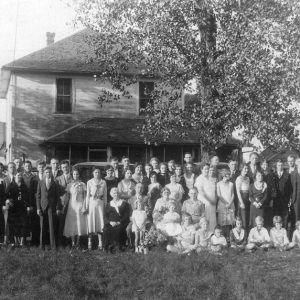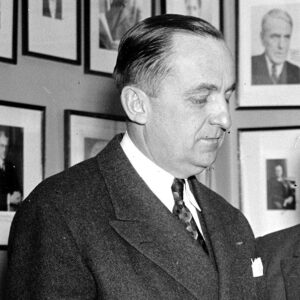calsfoundation@cals.org
John Carroll Cone (1891–1976)
John Carroll Cone was a promoter of aviation in Arkansas and established two significant air organizations in the late 1920s—the 154th Observation Squadron of the Arkansas National Guard and the Command-Aire manufacturing company. During his later career, he advised two U.S. presidents in commercial aviation policy.
Carroll Cone was born on July 4, 1891, in the Snyder community of Ashley County) to Jesse H. and Annie A. Cone. He attended Ouachita Baptist College, now Ouachita Baptist University (OBU), prior to enlisting in the United States Army and volunteering for training in the Army Air Service. A veteran fighter pilot with three probable kills but only one confirmed kill in combat during World War I, Cone proved more valuable as an instructor than as a fighter. As in any new technological field, such as aviation was in the 1910s, the ability to spot talent suited for training was vital, and one of Cone’s great discoveries was Eddie Rickenbacker, who went on to claim the highest total of confirmed enemy aircraft shot down by an American during World War I.
Returning home from Europe to promote the value of aviation in his native state, Cone’s first accomplishment was the establishment of an air wing of the Arkansas National Guard (ANG). Cone was the state auditor from 1925 to 1929, and his political connections to President Calvin Coolidge helped establish the 154th Observation Squadron in 1925. Appointed as a lieutenant colonel in the ANG, Cone served as the commanding officer for the 154th. Within two years of its formation, the 154th proved its worth by providing crude air drops of food and necessities to stranded Arkansans during the great Mississippi River floods of 1927 and 1929.
The formation of the ANG air unit was one example of Cone’s campaign to make aviation a part of Arkansans’ daily life. He was twice elected as Arkansas’s state auditor, and he conducted his campaign in 1924 by touring the state in his own biplane. He also used his influence in state government to bring aviation to citizens by creating the first airport development program, serving as the state’s first aeronautics director, and hosting aviation events, such as the 1926 National Elimination Balloon and Aeroplane Race in Little Rock (Pulaski County).
In 1926, Cone partnered with W. F. Moody to create the Arkansas Aircraft Company, locating in the building vacated by the failed Climber Automotive near the Little Rock Airport. Regional aircraft manufacturers were common during the mid-1920s, mimicking the early development of the automobile industry in the pre–World War I era. Arkansas Aircraft struggled until Cone hired a new chief engineer, Albert Vollmecke. The German immigrant’s designs gave Cone new products with which to approach Memphis, Tennessee, financier Robert Snowden Jr., who invested in the company. The name was changed to Command-Aire Corporation in 1928, and Cone became sales director.
Marketing its products on safety and easy operation for the average citizen, Command-Aire rapidly grew into one of the nation’s top twelve aircraft companies. Vollmecke’s factory-standard design was entered into the 1929 Daniel Guggenheim International Aircraft Competition. Competing against one-of-a-kind aircraft technology from many of the nation’s leading aviation companies, the Command-Aire biplane made it deep into the competition before failing at one test and finishing behind the Curtiss Tanager.
A crash in the aviation market in late 1928 and early 1929 was exacerbated by the stock market crash in October 1929. With little demand for aircraft for private pilots, and investment capital gone, Cone and his business associates attempted to position Command-Aire for merger into one of the emerging aviation conglomerates. By the end of 1929, missed opportunities left Command-Aire with a product line but no distribution network. As a result, the company was shut out of the mergers and had to cease production in January 1930. Bankruptcy followed later in the year.
Cone joined with company vice president Charles Taylor and members of the Little Rock Chamber of Commerce for one last piece of aviation glory in the summer of 1930. Using a racing design created by Vollmecke, the Little Rocket was entered by the central Arkansas consortium in the All-American Flying Derby in July 1930 as a potential sportsman’s airplane. The Little Rocket, a Command-Aire MR-1, was piloted by Lee Gehlbach to a stunning victory in the national cross-country race. Despite a hero’s welcome for the aircraft and pilot, the golden age of aviation was over for Arkansas.
With his company in receivership, Cone left the state for Washington DC to become an assistant director for the Air Commerce Bureau from 1933 to 1936. The next year, he was hired by Pan American to manage the north Atlantic division of one of the nation’s flagship airlines. He became the operations supervisor for one of its most famous routes, the Yankee Clipper, which inaugurated commercial seaplane service across the Atlantic. He continued with Pan Am until retirement in 1969, reaching the level of vice president. He remained involved in government aviation policy at a national level as an advisor on commercial aviation to Presidents Franklin D. Roosevelt and Harry Truman. A former Democratic Party candidate for governor in Arkansas, Cone went on to serve as the vice chair for the Finance Committee of the Democratic National Committee. Married twice, Cone died in Bethesda, Maryland, on August 11, 1976, and was survived by four children. He is buried in Arlington National Cemetery.
For additional information:
“Aviation Pioneer, Former Auditor Dies at Age 83.” Arkansas Gazette. August 13, 1976, p. 12B.
John Carroll Cone File. Arkansas Aviation Historical Society Archives, Little Rock, Arkansas.
William M. Smith
University of Arkansas, Fayetteville
 Business, Commerce, and Industry
Business, Commerce, and Industry Early Twentieth Century, 1901 through 1940
Early Twentieth Century, 1901 through 1940 Military
Military Politics and Government
Politics and Government Transportation
Transportation 154th Observation Squadron
154th Observation Squadron  Cone Trophy
Cone Trophy  John Cone House
John Cone House  John Carroll Cone
John Carroll Cone 




Comments
No comments on this entry yet.